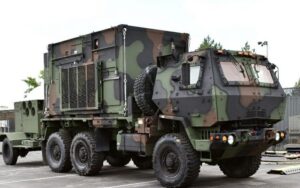Northrop Grumman’s [NOC] pre-prototype for the Tactical Intelligence Targeting Access Node (TITAN) program participated in the Army’s Project Convergence experiment, the company said on Wednesday, demonstrating the mobile system’s capability to bring in space assets for advanced sensing and targeting.
“The mobile, semi-autonomous pre-prototype system leverages commercial and military space assets to facilitate deep-sensing, reduce sensor-to-shooter timelines and maximize the effectiveness of long-range precision fires,” Northrop Grumman wrote in a statement. “This new capability fully integrates data from multiple assets into a single mobile system. The groundbreaking technology supports the Department of Defense’s strategy for its JADC2 network to conduct multi-domain operations.”

The TITAN program is expected to deliver scalable and expeditionary intelligence ground stations capable of providing fused sensor data to weapons systems at the battalion level, with the Army describing the future system as “a crucial component to enable deep sensing and [shortening] the sensor-to-shooter loop.”
The Army selected Northrop Grumman to work on TITAN in 2020, noting its pre-prototype work could prove out the potential for utilizing space assets, such as low-Earth orbit satellites, to improve situational awareness and tactical intelligence in contested environments (Defense Daily, Sept. 1 2020).
In late June, Palantir [PLTR] and Raytheon Technologies [RTX] each received $36 million, 14-month deals from the Army to build TITAN ground station prototypes for evaluation and testing after both companies participated in an initial phase to work through their designs (Defense Daily, June 28).
Army officials described Northrop Grumman’s space pre-prototype as a component kit that will allow the future TITAN ground station to integrate with space-based capabilities.
“Our TITAN solution is a pioneering technology integrating critical space capabilities into a mobile system,” Pablo Pezzimenti, Northrop Grumman’s vice president of integrated national systems, said in a statement. “Our unique ability to provide access to multi-domain, actionable intelligence from commercial and military space systems directly contributes to success on the battlefield by helping the warfighter make quicker decisions when every second counts.”
Mark Kitz, head of the Program Executive Office Intelligence Electronic Warfare & Sensors, previously told reporters that after the Army’s first Multi-Domain Task Force (MDTF) based out of Joint Base Lewis-McChord in Washington used the TITAN pre-prototype space-ground component kit at Project Convergence, another pre-prototype is set to go to the second MDTF in Europe (Defense Daily, Aug. 31).
“They will organically operate it. It is a capability that we have delivered to them. It is our first full-up prototype delivering integrated data to analyst shooter, whoever the consumer is. One of the really exciting things is the actual first MDTF users are integrating those data sensors and those data feeds,” Kitz said at the time.
The Army is currently pursuing two variants of TITAN, starting with an “Advanced” version on heavier platforms such as tactical trucks with space direct downlink capability and a “Basic” model designed for platforms such as the Joint Light Tactical Vehicle (JLTV).